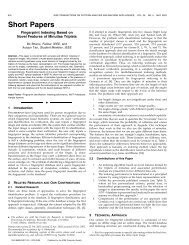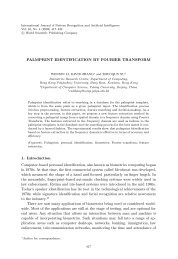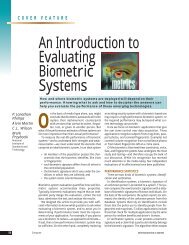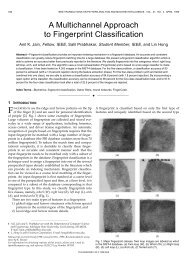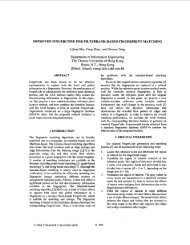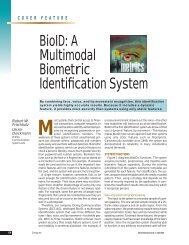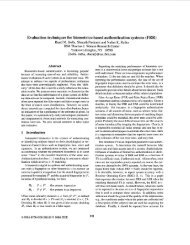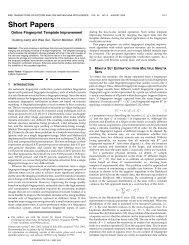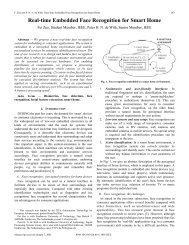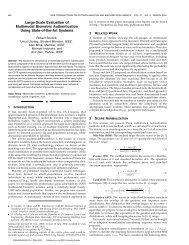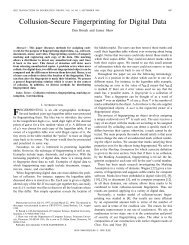Automated personal identification by palmprint
Automated personal identification by palmprint
Automated personal identification by palmprint
Create successful ePaper yourself
Turn your PDF publications into a flip-book with our unique Google optimized e-Paper software.
<strong>Automated</strong> <strong>personal</strong> <strong>identification</strong> <strong>by</strong> <strong>palmprint</strong><br />
Wei Shu<br />
David Zhang<br />
City University of Hong Kong<br />
Department of Computer Science<br />
Kowloon, Hong Kong<br />
E-mail: dapeng@cs.cityu.edu.hk<br />
cswshu@cityu.edu.hk<br />
Abstract. We present a <strong>palmprint</strong> approach to identifying individuals.<br />
Some significant features covering both geometrical and structural characteristics<br />
can be extracted from the <strong>palmprint</strong> to distinguish a person<br />
from others. The experiments show that this approach can be effectively<br />
used as a new biometric technology for automated <strong>personal</strong> <strong>identification</strong>.<br />
© 1998 Society of Photo-Optical Instrumentation Engineers.<br />
[S0091-3286(98)01908-4]<br />
Subject terms: <strong>personal</strong> <strong>identification</strong>; <strong>palmprint</strong>; biometrics; pattern recognition.<br />
Paper 09117 received Nov. 12, 1997; revised manuscript received Feb. 19, 1998;<br />
accepted for publication Feb. 19, 1998.<br />
1 Introduction<br />
<strong>Automated</strong> biometric-based <strong>identification</strong> means verifying<br />
or recognizing the identity of a live person on the basis of<br />
some physical or behavioral characteristics. There have<br />
been two current approaches—fingerprint <strong>identification</strong> and<br />
hand geometry <strong>identification</strong>—in <strong>personal</strong> <strong>identification</strong><br />
that are based on the measurement and comparison of the<br />
features extracted from the person’s hand. 1,2 Fingerprint<br />
<strong>identification</strong> is the most widespread application of biometrics<br />
technology, where some small unique features known<br />
as minutiae are used to build the corresponding eigenspace.<br />
However, it is still a difficult task to detect the minutiae<br />
from the fingers of elderly people and manual<br />
laborers. 3 For hand <strong>identification</strong> with the threedimensional<br />
shape, one could fool the system <strong>by</strong> capturing<br />
a person’s hand geometry and creating a fake hand. 1<br />
Palmprint <strong>identification</strong> can tackle these problems because<br />
it deals with relatively stable physical characteristics,<br />
basically unalterable without trauma to the individual. 4<br />
This means that many useful features, besides those extracted<br />
from both fingerprint and hand shape, can be simultaneously<br />
obtained from a <strong>palmprint</strong>. However, they have<br />
never been applied to identify individuals in biometric systems,<br />
except for the shape of the hand. Therefore, it is<br />
necessary to develop a new approach to automated <strong>personal</strong><br />
<strong>identification</strong> <strong>by</strong> <strong>palmprint</strong>.<br />
2 Notation and Definitions<br />
In a <strong>palmprint</strong> see Fig. 1, there are three principal lines,<br />
called as the lines of the life, heart, and head. They are<br />
unique and unchanging, and cannot be forged. In addition,<br />
two end points, a and b, can be obtained from the intersections<br />
of principal lines with the two sides of the palm.<br />
Because of the stability of the principal lines, the end points<br />
and their midpoint o remain unchanged from year to year.<br />
Some significant properties can be observed as follows: 1<br />
the locations of the endpoints and their midpoint are<br />
rotation-invariant; 2 a two-dimensional rectangular coordinate<br />
system can be established uniquely, of which the<br />
origin is the midpoint o and the x axis passes through the<br />
endpoints; 3 the size of a palm can also be uniquely specified<br />
<strong>by</strong> the Euclidean distance between two end points together<br />
with the length of their perpendicular bisector in the<br />
palm segment cd in Fig. 2; 4 a palm can be divided into<br />
three regions finger-root region, inside region, and outside<br />
region <strong>by</strong> the line segment connecting the end points and<br />
its perpendicular bisector. As a result, the endpoints and<br />
their midpoint can serve as registrations for automatic<br />
matching because of their invariable locations.<br />
3 Palmprint Features<br />
There is rich and useful information in a <strong>palmprint</strong>. Some<br />
kinds of features are as follows:<br />
1 Geometry features: According to the palm’s shape,<br />
we can extract the corresponding geometry features,<br />
such as width, length, and area, which can be easily<br />
detected.<br />
2<br />
Principal-line Features: Both location and form of<br />
principal lines in a <strong>palmprint</strong> are very important<br />
physiological characteristics to identify an individual,<br />
because they vary little from time to time.<br />
3 Wrinkle features: In a <strong>palmprint</strong>, there are many<br />
wrinkles, which are different from the principal<br />
Fig. 1 Definitions for a <strong>palmprint</strong>: principal lines (1, heart line; 2,<br />
head line; 3, life line), regions (I, finger-root region; II, inside region;<br />
III, outside region), end points (a and b), and their midpoint (o).<br />
Opt. Eng. 37(8) 2359–2362 (August 1998) 0091-3286/98/$10.00 © 1998 Society of Photo-Optical Instrumentation Engineers<br />
2359
Shu and Zhang: <strong>Automated</strong> <strong>personal</strong> <strong>identification</strong> ...<br />
Fig. 2 Geometry features and delta-point features of a <strong>palmprint</strong>,<br />
where cd is the perpendicular bisector of segment ab and points 1<br />
to 5 are delta points.<br />
Fig. 4 Directional image of a <strong>palmprint</strong> (different gray levels represent<br />
different directions, and the center of each white circle corresponds<br />
with a delta point shown in Fig. 2).<br />
lines in that they are thinner and more irregular, so<br />
more detailed features can be obtained.<br />
4 Delta-point features: A delta point is defined as the<br />
center of a delta-like region in the <strong>palmprint</strong>. 5 It is<br />
known that there always are some delta points located<br />
in the finger-root region and the outside region<br />
e.g., points 1 to 5 in Fig. 2. This makes it possible<br />
to acquire these features and establish their stability<br />
and uniqueness.<br />
5 Minutiae features: A <strong>palmprint</strong> is basically composed<br />
of ridges; hence the minutiae can be used to<br />
extract stable and unique features.<br />
In principle, the features mentioned above can be determined<br />
from <strong>palmprint</strong> images with fine resolution and used<br />
for <strong>identification</strong>.<br />
4 Feature Extraction<br />
In general, geometry features, principal-line features, and<br />
wrinkle features can be obtained from a low-resolution image,<br />
even a low-quality one. As delta points can be effectively<br />
located in a directional image, 5,6 delta-point features<br />
can be extracted from a fine-resolution <strong>palmprint</strong> image<br />
even in the presence of noise. However, minutiae can be<br />
detected only from the high-quality and fine-resolution images.<br />
For example, the minutiae in a small region of a<br />
<strong>palmprint</strong> and a directional image produced from Fig. 2 are<br />
shown in Fig. 3 and Fig. 4, respectively. In Fig. 4, the delta<br />
points correspond with the pixels around which there are at<br />
least three directions. The spatial resolution of these <strong>palmprint</strong><br />
images is 400 dots per inch dpi. Some principal-line<br />
features can also be extracted from an image whose resolution<br />
is 100 dpi see Fig. 5.<br />
Obviously, principal-line features have the advantage of<br />
requiring lower spatial resolution, so that the <strong>palmprint</strong> image<br />
can be smaller and the system is less sensitive to noise.<br />
Some significant features that can be detected from palm-<br />
Fig. 3 A small region of a <strong>palmprint</strong> and the minutiae extracted from<br />
it.<br />
Fig. 5 Some principal-line features determined from the <strong>palmprint</strong><br />
image with low spatial resolution.<br />
2360 Optical Engineering, Vol. 37 No. 8, August 1998
Shu and Zhang: <strong>Automated</strong> <strong>personal</strong> <strong>identification</strong> ...<br />
Table 1 The FRR and FAR using the different features in the <strong>palmprint</strong>. F 1 : geometry features; F 2 :<br />
eight points on the principal lines; F 3 : twelve points on the principal lines; F 4 : F 1 and F 2 ; F 5 : F 1 and<br />
F 3 .<br />
Value (%)<br />
F 1 F 2 F 3 F 4 F 5<br />
Threshold FRR FAR FRR FAR FRR FAR FRR FAR FRR FAR<br />
T 0<br />
0 11.1 0 0.8 0 0.7 0 0.2 0 0<br />
T 1<br />
13 8.2 8 0.7 4 0.5 8 0.2<br />
T 2<br />
31 4.7 33 0.2 8 0.2 33 0.2<br />
T 3<br />
71 1.9 46 0.2 21 0.1 46 0.2<br />
T 4<br />
100 0 46 0 31 0 46 0 0 0<br />
print images with low spatial resolution are as follows:<br />
First the geometry features width and length as defined in<br />
Fig. 2, are obtained easily once the pair of end points, a and<br />
b, are located. Second, several points on the principal lines<br />
can be detected to describe the structural properties of the<br />
principal lines. Here, the points with the distances of nl<br />
(n1,2,...,N) from the point a are chosen on the life line,<br />
where l is a distance parameter and N is the number of<br />
points. In the same way, the points on the heart line are<br />
located <strong>by</strong> the distances between them and the point b.<br />
5 Experimental Results<br />
An <strong>identification</strong> parameter, r ij , can be calculated as<br />
n<br />
r ij 1<br />
k1<br />
wk f i<br />
k f k j <br />
f k i f k j ,<br />
where n is the number of features; the weight w(k) is between<br />
0 and 1 (k1,...,n), and k1 w(k)1; f k k<br />
n<br />
i and f j<br />
are the kth features of sample i and j, respectively. In<br />
addition, the measure of acceptance or rejection is defined<br />
as<br />
I ij 1 0<br />
if r ij T accept,<br />
otherwise reject,<br />
where T is a threshold.<br />
Three experiments based on different features are performed,<br />
where five thresholds are named T i (i0,1,...,4).<br />
T 0 (T 4 ) is the minimum maximum r ij of the same different<br />
<strong>palmprint</strong>s, and T i T 0 i(T 4 T 0 )/4 i1,2,3;<br />
T 4 T 0 . The weights w(k) are obtained from experience.<br />
The geometry features are used to verify the <strong>palmprint</strong> images<br />
in the first experiment. Next, the principal-line features<br />
are acquired, and the Euclidean distance between each<br />
point and the midpoint o is calculated as the feature. Eight<br />
or twelve points are chosen to represent principal-line features.<br />
In the third experiment, we use a multistep <strong>identification</strong><br />
method, where geometrical features are compared to<br />
eliminate some <strong>palmprint</strong>s when the threshold is not more<br />
than T 0 and principal-line features are employed to process<br />
the remaining <strong>palmprint</strong>s for fine-level matching.<br />
1<br />
2<br />
The measure of the experimental result is provided <strong>by</strong> a<br />
subtle pair of statistics known as the false-rejection rate<br />
FRR and false-acceptance rate FAR. The FRR FAR is<br />
the number of false rejections acceptances divided <strong>by</strong> the<br />
number of prints the same different palms.<br />
All experiments were conducted on a database containing<br />
48 pairs of prints the same palm and 844 pairs of prints<br />
of different palms. The experimental results shown in Table<br />
1 are three sets of FARs and FRRs obtained <strong>by</strong> using different<br />
features. They show that the <strong>identification</strong> accuracy<br />
is acceptable when twelve points on the principal lines are<br />
applied in the multistep <strong>identification</strong>. Obviously, the experiment<br />
with the multistep <strong>identification</strong> feature is better<br />
than the others, and the more features are used, the better<br />
we meet the demand for <strong>personal</strong> <strong>identification</strong>.<br />
6 Conclusions<br />
As a new attempt at biometric-based authentication, in this<br />
paper, we have explored automated <strong>palmprint</strong> <strong>identification</strong><br />
as an approach to countering some insufficiencies in fingerprint<br />
and hand <strong>identification</strong>. In principle, the proposed approach<br />
is both foolproof and convenient, because many significant<br />
physiological characteristics, which are unique,<br />
unchanging and easily extracted, can be employed to identify<br />
individuals. Some features have been extracted to test<br />
the effectiveness of this approach, and the preliminary results<br />
suggest that <strong>palmprint</strong>s can be effectively applied to<br />
identity verification. The technique works well in the presence<br />
of noise in the <strong>palmprint</strong> image, because the features<br />
adopted can be obtained from a low-resolution image.<br />
More effective features, such as delta points and minutiae,<br />
can be gained when both the resolution and the quality of<br />
the <strong>palmprint</strong> image are high. It is believed that this approach<br />
can have practical application to automated <strong>personal</strong><br />
<strong>identification</strong> as a new biometric technology.<br />
References<br />
1. B. Miller, ‘‘Vital signs of identity,’’ IEEE Spectrum 312, 22–30<br />
1994.<br />
2. D. R. Richards, ‘‘Rules of thumb for biometric systems,’’ Security<br />
Management 3910, 67–71 1995.<br />
3. L. Coetzee and E. C. Botha, ‘‘Fingerprint recognition in low quality<br />
images,’’ Pattern Recognition 2610, 1441–1460 1993.<br />
4. M. Elecion, ‘‘Automatic fingerprint <strong>identification</strong>,’’ IEEE Spectrum<br />
109, 36–45 1973.<br />
5. V. S. Srinivasan and N. N. Murthy, ‘‘Detection of singular points in<br />
fingerprint images,’’ Pattern Recognition 252, 139–153 1992.<br />
Optical Engineering, Vol. 37 No. 8, August 1998<br />
2361
Shu and Zhang: <strong>Automated</strong> <strong>personal</strong> <strong>identification</strong> ...<br />
6. K. Karu and A. K. Jain, ‘‘Fingerprint classification,’’ Pattern Recognition<br />
293, 389–404 1996.<br />
Wei Shu received the BE degree in automation<br />
control and the ME degree in pattern<br />
recognition and intelligence control<br />
from Tsinghua University, Beijing, in 1990<br />
and 1994, respectively. He is currently a<br />
research assistant in the Department of<br />
Computer Science at City University of<br />
Hong Kong as well as a PhD student in the<br />
Department of Automation at Tsinghua<br />
University. His research interests include<br />
pattern recognition, image analysis, and<br />
biometrics.<br />
second PhD, in electrical and computer engineering, at the University<br />
of Waterloo, Ontario, Canada, in 1994. Currently, he is an associate<br />
professor in City University of Hong Kong. His research areas<br />
include automated biometric-based <strong>identification</strong>, neural<br />
systems and applications, VLSI system design methodology, and<br />
parallel computer architecture. He has authored and coauthored<br />
nearly 100 papers and two books, and has received several project<br />
awards. Dr. Zhang is a senior member of the IEEE.<br />
David Zhang graduated in computer science<br />
from Peking University in 1974 and<br />
received his MSc and PhD degrees in<br />
computer science and engineering from<br />
Harbin Institute of Technology (HIT) in<br />
1983 and 1985, respectively. From 1986<br />
to 1988 he was a postdoctoral fellow at<br />
Tsinghua University, and he became an<br />
associate professor at Academia Sinica,<br />
Beijing, China. In 1988, he joined the University<br />
of Windsor, Ontario, Canada, as a<br />
visiting research fellow in electrical engineering. He received his<br />
2362 Optical Engineering, Vol. 37 No. 8, August 1998



